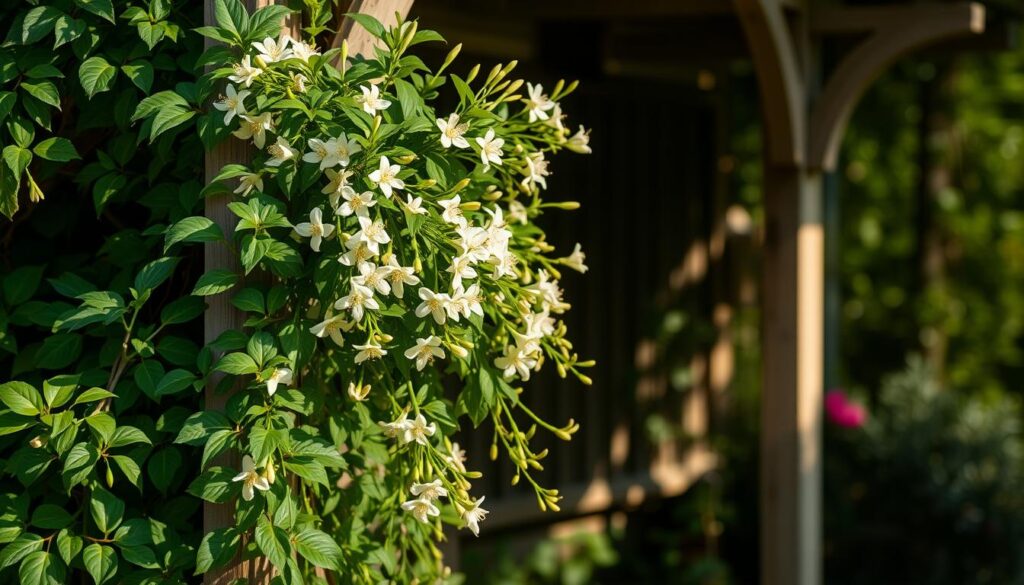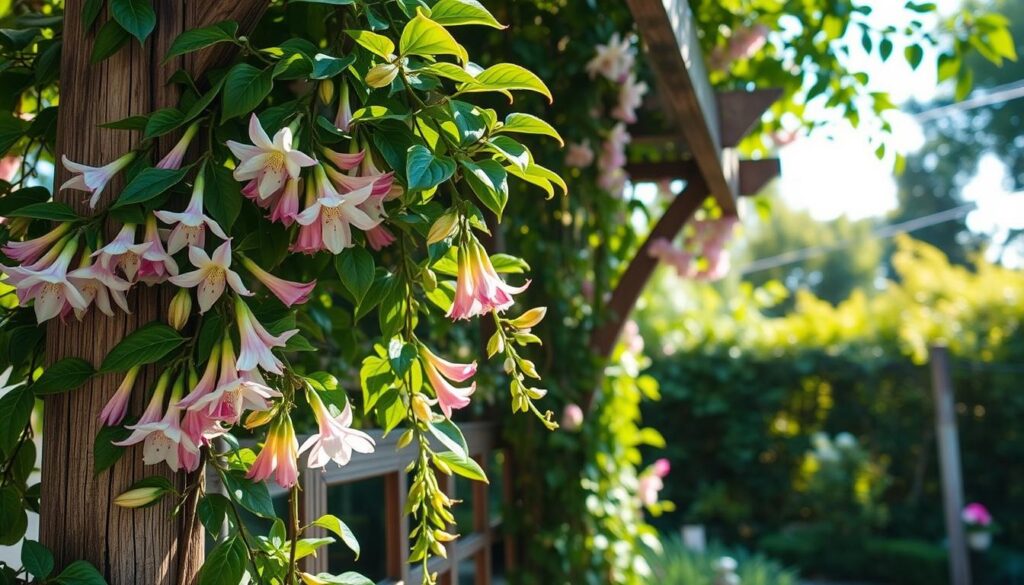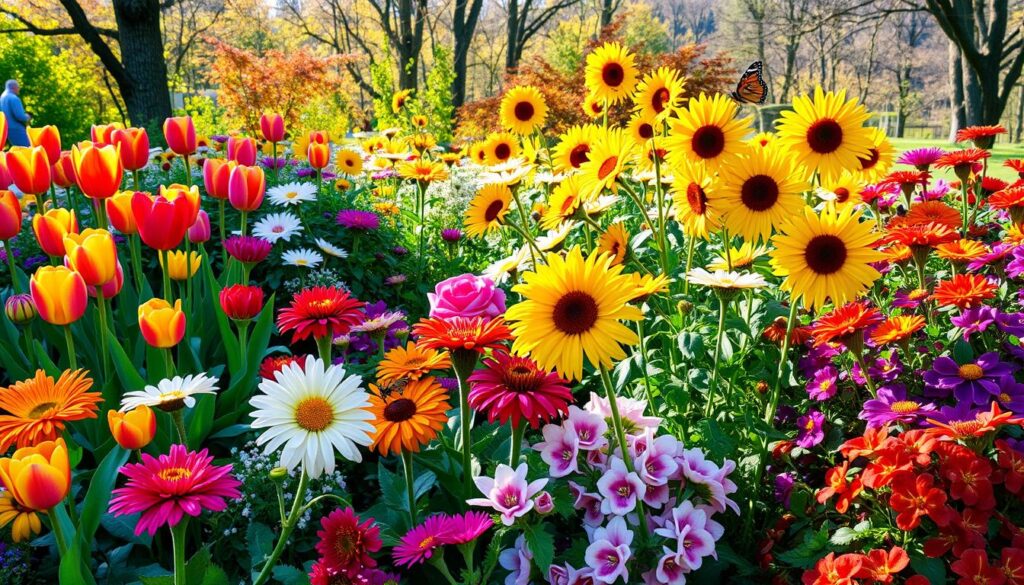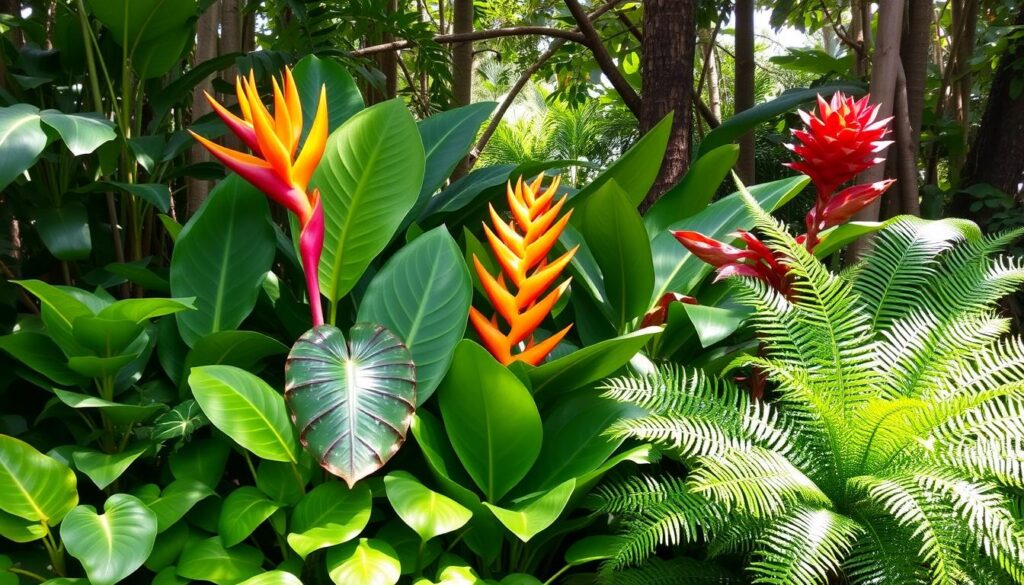How to Grow and Care for Enchanting Honeysuckle Plants

Imagine having a fragrant vine in your garden. It has trumpet-shaped flowers that attract pollinators and add elegance.
Honeysuckle plants are popular because they’re easy to care for and grow well in many conditions. They can climb up trellises, arbors, or trees, perfect for small gardens.
With the right care, honeysuckle plants bloom for months. They fill the air with sweet fragrance and attract wildlife.
Whether you’re new to gardening or experienced, growing honeysuckle can be rewarding. We’ll cover the basics of care, from planting to pruning, to help you enjoy these beautiful vines.
Understanding Honeysuckle: A Brief Overview
Honeysuckle plants are known for their fragrant, trumpet-shaped flowers in many colors. They are a favorite among gardeners for their beauty and scent. As a garden vine, honeysuckle can climb up walls or trellises, adding beauty to any garden.
Choosing the right honeysuckle plant is key. Each variety has its own look, growth, and needs. Popular ones include Lonicera sempervirens, Lonicera japonica, and Lonicera fragrantissima. Picking the right one ensures your plant will bloom beautifully and smell sweet.
Knowing about honeysuckle varieties helps gardeners care for their plants better. Whether you want a colorful shrub or a climbing vine, honeysuckle is a great choice. With the right care, honeysuckle plants can bring beauty and fragrance to your garden for years.
What is Honeysuckle?
Honeysuckle is a flowering plant in the Lonicera genus. It’s famous for its fragrant, trumpet-shaped flowers in white, yellow, pink, and red.
Varieties of Honeysuckle
There are many honeysuckle varieties, each with its own look and growth. Popular ones include Lonicera sempervirens, Lonicera japonica, and Lonicera fragrantissima. These can be used as vines, shrubs, or ground covers.
| Variety | Description | Growth Habit |
|---|---|---|
| Lonicera sempervirens | Evergreen honeysuckle with red, orange, or yellow flowers | Climbing vine |
| Lonicera japonica | Japanese honeysuckle with white, yellow, or pink flowers | Climbing vine or ground cover |
| Lonicera fragrantissima | Fragrant honeysuckle with white or yellow flowers | Flowering shrub |
Ideal Growing Conditions for Honeysuckle
Honeysuckle plants are loved for their sweet scent and beautiful flowers. They are a favorite in garden landscaping. To make them thrive, they need the right growing conditions.
They prefer well-drained soil. This lets their roots breathe and absorb nutrients well. It’s key for their health and beauty, helping them bloom more.
Honeysuckle plants need full sun to partial shade. They should get direct sunlight for at least six hours a day. But they can handle some shade, especially in warm places. The right sunlight helps them bloom more and stay colorful.
For more tips on growing honeysuckle, check out honeysuckle plant care. It has great advice for growing these lovely plants.
Honeysuckle plants like slightly acidic to neutral soil pH. They also do well in soil rich in organic matter. This helps keep moisture and provides nutrients. Knowing their sunlight and soil needs helps gardeners create the perfect environment for them.
Sunlight Requirements
Honeysuckle plants need a lot of sunlight to bloom. They can handle some shade but do best in full sun to partial shade. This makes them great for adding color and fragrance to outdoor spaces.
Soil Preferences
Honeysuckle plants like well-drained soil that’s rich in organic matter. They prefer a slightly acidic to neutral pH. The right soil helps them thrive, enjoying their sweet scent and beautiful flowers.
Planting Honeysuckle: Step-by-Step Guide
Planting honeysuckle is easy and requires some planning. Choose a spot with the right sunlight and soil. A fragrant vine like honeysuckle grows well in many places.
First, pick a spot that gets the right sunlight for your honeysuckle. Honeysuckle needs a trellis to climb. Make sure the area is big enough for the plant to grow.
After picking the spot, dig a hole that’s twice as wide and as deep as the plant’s roots. Add compost or manure to the soil. This helps the soil drain better and grow the plant.

With the right care, your honeysuckle will bloom beautifully. Follow these steps to enjoy this lovely vine in your garden.
Watering Honeysuckle Plants
Watering honeysuckle plants right is key, especially in their first year. They need steady moisture to grow well and look great in your garden. Aim to give them 1-2 inches of water each week, either from rain or a hose.
Frequency of Watering
How often to water honeysuckle plants depends on the weather and soil. Generally, water them when the top 2-3 inches of soil are dry. This avoids too much water, which can harm the roots.
Signs of Overwatering and Underwatering
Knowing the signs of too much or too little water is important. Too much water can turn leaves yellow and cause stems to droop. Too little water makes leaves wilt and grow poorly. Watch your plants closely and adjust your watering to keep them healthy and beautiful.
| Signs | Overwatering | Underwatering |
|---|---|---|
| Leaves | Yellowing, droopy | Wilted, brown edges |
| Stems | Droopy | Stunted growth |
| Roots | Root rot | Healthy |
Fertilizing Honeysuckle for Healthy Growth
Honeysuckle plants need regular fertilizing, especially when they’re growing. This fragrant vine loves nutrients to grow well and bloom. Using the right fertilizers at the right time helps honeysuckle plants thrive. They’re great for climbing up trellises and arbors.
Choosing the right fertilizer is key for honeysuckle. A balanced fertilizer with nitrogen, phosphorus, and potassium is best. It gives the plants what they need to grow and bloom.
Best Fertilizers to Use
Good fertilizers for honeysuckle include a 10-10-10 mix or a flowering plant fertilizer. Always follow the package instructions. Too much fertilizer can harm the plant.
Timing for Fertilization
Fertilize honeysuckle in the spring and summer. Fertilizing once a month during these months helps a lot. This way, your honeysuckle plants will stay healthy and bloom beautifully.
| Fertilizer Type | Nitrogen | Phosphorus | Potassium |
|---|---|---|---|
| 10-10-10 | 10% | 10% | 10% |
| Flowering Plant Fertilizer | 15% | 15% | 10% |
Pruning Honeysuckle for Optimal Health
Pruning is key for Lonicera plant care. It keeps the plant’s shape and promotes healthy growth. By pruning at the right time and using the right techniques, gardeners can get more flowers and vigorous growth. Regular pruning also stops the plant from becoming leggy and makes it fuller.
Timing is crucial when pruning honeysuckle. The best time varies by honeysuckle type and climate. Generally, prune in late winter or early spring, before new growth starts. This lets the plant focus on new flowers and leaves, not damaged stems.
Techniques for Effective Pruning
To prune honeysuckle well, use sharp, clean tools. Make cuts just above a leaf node. This stops disease spread and encourages new growth. Remove dead or damaged stems and any that cross or rub. These simple steps help Lonicera plants thrive and bloom beautifully.
Common Pests and Diseases Affecting Honeysuckle
Honeysuckle plants are known for their sweet scent and beautiful flowers. They can be a lovely addition to any garden. However, they can attract pests and diseases that harm their health and appearance.
Common pests include aphids, whiteflies, and spider mites. These pests can damage the plant’s leaves and flowers. Regular inspections and using organic or chemical controls are key to preventing infestations.
Honeysuckle plants can also get diseases like powdery mildew and leaf spot. These diseases can harm the leaves and stems. To prevent diseases, ensure good air circulation, water properly, and avoid over-fertilizing.
Prevention Strategies
To keep honeysuckle plants healthy, use prevention strategies like pruning, fertilizing, and watering properly. These steps can reduce the risk of pests and diseases. This way, gardeners can enjoy the beauty of their flowering shrub.
| Pest/Disease | Prevention Strategy |
|---|---|
| Aphids | Inspect plants regularly, use neem oil or insecticidal soap |
| Powdery Mildew | Provide good air circulation, water properly, avoid over-fertilizing |
| Spider Mites | Use organic or chemical controls, increase humidity around plants |
Disease Treatment
If a honeysuckle plant gets infected, treat it quickly to stop the disease from spreading. This might involve using fungicides, pruning infected areas, and improving air circulation around the plant.
Encouraging Pollinators with Honeysuckle
Honeysuckle plants are a fragrant vine that attracts bees and butterflies. They add beauty and fragrance to gardens. They also help attract pollinators, which is good for the ecosystem.
The sweet, fragrant flowers of Honeysuckle are a favorite among pollinators. Bees and butterflies love the nectar. This makes Honeysuckle great for gardens that want to attract pollinators.
Honeysuckle is also easy to care for. It grows well in different soils and can handle some drought. This makes it perfect for gardeners who want a beautiful garden with little work.
| Plant | Pollinators Attracted | Maintenance Level |
|---|---|---|
| Honeysuckle | Bees, butterflies | Low |
| Climbing plant | Bees, butterflies, hummingbirds | Medium |
| Fragrant vine | Bees, butterflies | Low |
Harvesting Honeysuckle Berries
As honeysuckle, or garden vine, grows, it fills with trumpet-shaped flowers. These flowers turn into juicy berries. Many gardeners love to pick these berries for jams, teas, and natural dyes.
The best time to pick honeysuckle berries is when they’re fully ripe. They should be deep purple and a bit soft. Make sure to only pick berries from safe Lonicera species, as some can be harmful.
Uses for Honeysuckle Berries
Honeysuckle berries are great for making jams and preserves. You can also dry them for tea or use them as a natural dye. They’re full of antioxidants and have been used in medicine for a long time.
Preserving Honeysuckle Berries
To keep honeysuckle berries fresh, you can freeze or dry them. Freezing keeps their taste and nutrients. Drying removes water, making them last longer. You can also make syrup by cooking the berries with sugar and water. This syrup is good for teas, desserts, or as a topping.
| Use | Method | Benefits |
|---|---|---|
| Jam-making | Cooking with sugar and pectin | Delicious spread, rich in antioxidants |
| Tea | Drying or freezing | Rich in antioxidants, calming effects |
| Natural dye | Boiling with fabric or material | Unique, natural color, eco-friendly |
Seasonal Care for Honeysuckle Plants
Caring for honeysuckle plants is a year-round job. You need to change your care plan with the seasons. Honeysuckle is a flowering shrub that adds beauty and a sweet scent to gardens.
In winter, protect honeysuckle from cold. Use mulch to keep moisture in and soil warm. In spring, honeysuckle needs pruning to grow more flowers and keep its shape.
Honeysuckle plants make a fragrant border in gardens. Their sweet scent is a big draw for gardeners. With the right care, honeysuckle plants bloom all year, bringing beauty and fragrance to your garden.
| Season | Care Requirements |
|---|---|
| Winter | Apply mulch, protect from cold temperatures |
| Spring | Prune to promote new growth, maintain shape |
Follow these seasonal care tips to keep honeysuckle plants healthy. Whether in your garden or as a flowering shrub, honeysuckle adds beauty and fragrance. It attracts pollinators and enhances your garden’s beauty.
Conclusion: Enjoy the Beauty of Honeysuckle in Your Garden
Growing honeysuckle plants is a rewarding experience. It adds a fragrant, beautiful, and attractive touch to your garden. This article provides helpful tips and guidelines for growing these enchanting climbing plants.
Honeysuckle is perfect for both new and experienced gardeners. It can turn any outdoor space into a lively, scented oasis. With the right care, these vines will flourish, offering beauty and fragrance all year.
Start growing honeysuckle today to make your garden more charming. It will attract pollinators and create a peaceful, natural retreat. Let honeysuckle inspire you to create a magical outdoor space.
Recommended content: Fern plant.

